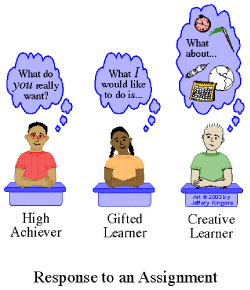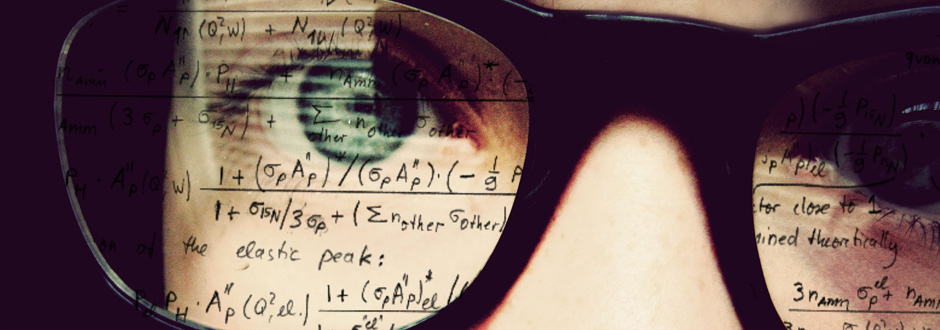 If you are the parent of a creative child, you are aware of your child’s ability to think differently from other children. However, teachers may have a more difficult time appreciating the creative thinker, unless that child demonstrates their creativity through the arts. This is because creative children are more likely to demonstrate the following qualities: daydreaming, wanting to work alone, sharing bizarre thoughts and conflicting opinions, and on top of this, these children may not be motivated by grades. None of these are qualities which are appreciated in the traditional classroom.
If you are the parent of a creative child, you are aware of your child’s ability to think differently from other children. However, teachers may have a more difficult time appreciating the creative thinker, unless that child demonstrates their creativity through the arts. This is because creative children are more likely to demonstrate the following qualities: daydreaming, wanting to work alone, sharing bizarre thoughts and conflicting opinions, and on top of this, these children may not be motivated by grades. None of these are qualities which are appreciated in the traditional classroom.
As a teacher, I generally found the creative child a joy to have in class; however, their lack of conformity to the classroom structure can be confused with attention deficit hyperactivity disorder. Highly creative children often require more individualized attention. Creative children need to be taught how to follow structure and how to work within the confines of time constraints without sacrificing their creativity.
I once worked with a creative 5th grade girl who upon completing a report for her other class arrived at school dressed as one of the characters in her homework assignment; she brought props to use as she read her report to the class. Her teacher was upset the girl had not followed directions, the teacher explained her costume and props were not in the directions and therefore not allowed.
Sadly there are studies which show children’s creativity begins to drop off once they start school. This is a perfect example of a child being reprimanded for going over and beyond and therefore another spark of creativity was squashed. The girl in her need to be creative had taken what she saw as a “boring assignment” and jazzed it up as a means to express her creativity. The teacher saw this as an act of rebellion; however, the other students probably would have been entertained by her presentation and the bar would have been raised for other students to think creatively with their next reports. The teacher didn’t have to require students to create props or dress up (some would be mortified at the idea of wearing a costume), but if the option was there to add a creative twist to their homework, then those with latent creativity could take the challenge.
Dr. Bertie Kingore, an international consultant and author who was recognized as the first Texas Gifted Educator of the year, created a chart I only recently came across explaining the differences between high-achievers, gifted children and creative thinkers. It is worth considering in raising and teaching children. You can find the chart at the end of this article. There has been a lot said in recent years about schools stifling creativity. If we want schools to see the importance of supporting creative thinking, it would help if they could also recognize the creative child within the school.
Parents and teachers can use this chart to identify the creative, gifted or high-achieving child and prescriptively use this chart to broaden a child’s learning experience. Excellent resources are listed at the end of this article.
Creative children have their own sets of needs and contributions to offer to the classroom, society and their families. While the creative child may share ideas which seem really “out there” to others, there is an upside to recognizing the creative thinkers in our lives. They are often great at generating new ideas and sparking healthy debates and they tend to have a keen sense of humor. Whether a child is creative, gifted or high-achieving, understanding how they learn and think can help all three develop a synergistic balance in their approach to learning.
Dr. Bertie Kigore’s chart: (mobile devices may need to be turned to view entire chart)
|
|||||||||||||||||||||||||||||||||||||||||||||||||||||||||||||||||||||||||||||||||
Other resources:
Read more of Dr. Kingore’s article: High Achiever, Gifted Learner, Creative Thinker
These are the best resources we have found for cultivating creativity in children: https://www.exquisite-minds.com/creative-learning/
Permission was granted to include Dr. Kingore’s chart.




Gifted children are extremely curious about objects, ideas or evwnts. They are good guessers and rapidly construct hypothesis. They are elaborate thinkers who produce new steps to basic problems. They are fluent thinkers who generates related ideas. They are willing to entertain complexity and seem to thrive on problem solving.
It’s interesting how easily this might be applied to adults in the world of work. Though its no surprise really, since creative children grow up to be creative adults.
Thanks for posting this.
Thank you so much for writing this. I cried when I read it. My first child very much falls under that category of ‘high achiever’, and went into school system with no problems, but I have struggled so much with my second in school, who falls into the ‘creative thinker’ category. This gives me courage to know that her struggle in the system is not hers alone, she just needs different guidance.
I also have a high achiever and a creative child. My daughter is a high achiever and can easily maneuver in public school. She does well with no problem. My creative son struggles in school as he isn’t offered a creative outlet except for writing. He prefers to design and draw. He is an excellent artist. Math is a HUGE struggle. At this point, it appears that a private school may be a better option for him. If anyone has had a similar experience, I would love some advice about how to support him.
I have a daughter aged 5 who is a high achiever – my son age 9 is a creative thinker! I have for a long time felt it’s somewhere I have gone wrong with my son, however since my daihgghter has started school I have realised it’s just the child and who they are. It’s been a massive eye opener!! My son is exactly the same as above. He loves drawing, creating, exploring, science experiments! Inventing ! Anything creative! But maths and English are a hugh struggle ;( . His school is very acedemic driven and don’t seem to care about his creative side…. he genuinely doesn’t seem happy at school I’m totally lost of what to do…
Hi, it is true many classrooms focus primarily on academics. There is less time for teachers to add in lessons which focus on the arts and/or creativity. For many teachers, it’s not that they don’t want to, it’s that they don’t have the time. Teachers today are under a lot of pressure to prepare students for standardized testing and the following year. That being said, perhaps it would help your son if you were able to request the teacher who is most likely to encourage creativity. This article will tell you how to go about this process: https://www.exquisite-minds.com/idea-of-the-week/request-teacher/
Your son definitely needs a creative outlet and if the school cannot provide this, then hopefully you can offer him this at home. Good luck, I am sure I would have enjoyed both your children in class!
[…] from Bertie Kingore’s chart, posted on […]
[…] classroom environment discourage creativity, given the prescriptive nature of mainstream curricula. Stacia Garland wrote: “Creative children have their own sets of needs and contributions to offer to the […]
[…] with unusually advanced intellectual development are uniquely vulnerable. While they are complex, creative and intelligent, they may struggle with extra-sensitivity, boredom, and less developed social skills. As Mary finds […]
[…] also: How to Identify the Creative Child in the Classroom and IQ tests for […]
[…] Exquisite Minds of Gifted and Creative Children and Mensa International talk about different characteristics that creative children might display. […]